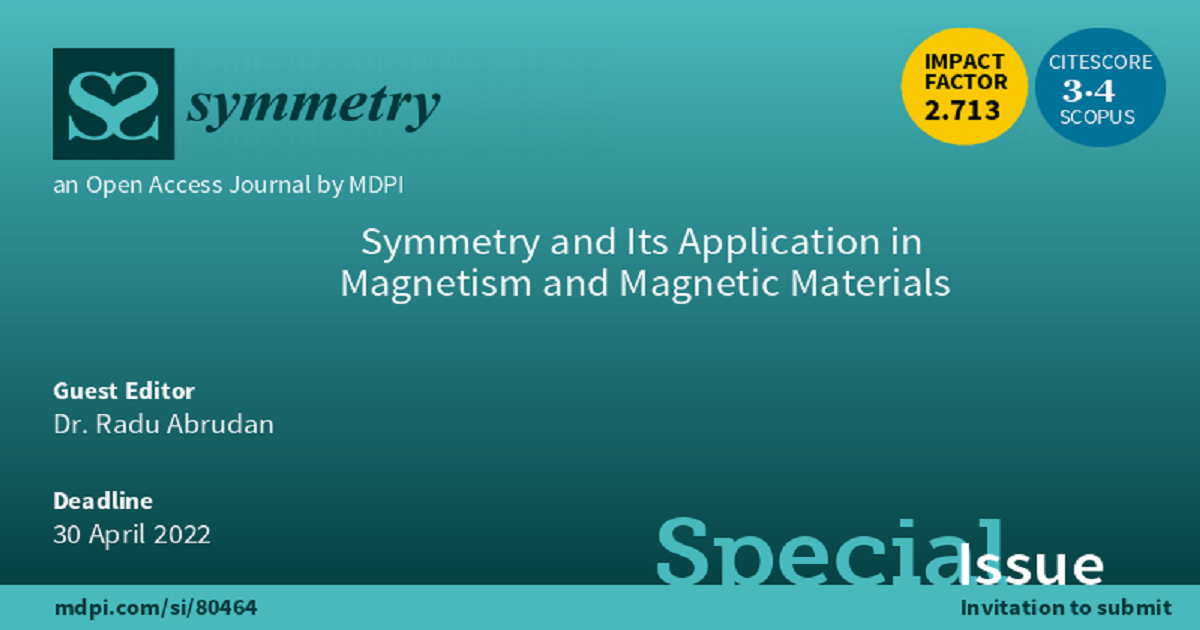Symmetry and Its Application in Magnetism and Magnetic Materials
A special issue of Symmetry (ISSN 2073-8994). This special issue belongs to the section "Physics".
Deadline for manuscript submissions: closed (30 April 2022) | Viewed by 11205

Special Issue Editor
Special Issue Information
Dear Colleagues,
Most of our surrounding physical world is guided by symmetry, which seems to be one of the omnipresent laws of the universe. Using symmetry, complex multidimensional systems can be easily explained and understood from both classical and quantum perspectives. Simplification relies on the fact that the system can be described by viewing one of its two identical aspects, even though the perspective views are different. On the other hand, theoretical local spontaneous symmetry breaking is responsible for the existence of crystals (breaking of transitional invariance) and magnetism (breaking of rotational invariance), as well as the superconductivity (where the phase of the charged particle is broken).
Properties of magnetic materials, bulk or thin films can be understood by taking into account their geometrical crystal symmetry (for crystalline structures) and/or their spin symmetry structure. Generally, one can include here ferromagnetic materials (e.g., 3d-transition metals and alloys), and antiferromagnetic materials (metallic alloys or oxides), as well as ferrimagnetic structures (3d-RE alloys, ferrites and garnets). Each of these types of magnetic materials exhibits an orderly distribution of their magnetic moments (spins) and the direction of this assumed spin can be seen as a repetitive feature on top of the geometrical description of the system (crystalline or amorphous).
Moreover, important aspects in magnetism and magnetic materials rely on distortion-affected symmetrical structures. Asymmetries of the ordered structures also lead to important aspects of some magnetic materials. Worth mentioning here is the antisymmetric part of the anisotropic (super)exchange interaction, later referred to as Dzyaloshinskii–Moriya interaction (DMI)—the fundamental interaction explaining the magnetic skyrmion structures or the magneto-electric effects in multiferroics.
The aim of this Special Issue is to pave the road for different possible experiments and publications having symmetry, magnetism and magnetic materials as common ground. Therefore, we encourage diverse contributions in a broad range of topics as follows:
- Ferromagnetic and antiferromagnetic (ferrimagnetic) materials;
- Skyrmions and other magnetic topological structures;
- Spin structures and spintronics;
- Symmetry breaking;
- Models in magnetism;
- Spin waves;
- Exchange-coupled systems;
- Low-dimensional systems;
- Molecular magnets;
- Multiferroics;
- Dynamics in magnetism;
- Magnetism in biological systems, etc.
Dr. Radu Abrudan
Guest Editor
Manuscript Submission Information
Manuscripts should be submitted online at www.mdpi.com by registering and logging in to this website. Once you are registered, click here to go to the submission form. Manuscripts can be submitted until the deadline. All submissions that pass pre-check are peer-reviewed. Accepted papers will be published continuously in the journal (as soon as accepted) and will be listed together on the special issue website. Research articles, review articles as well as short communications are invited. For planned papers, a title and short abstract (about 250 words) can be sent to the Editorial Office for assessment.
Submitted manuscripts should not have been published previously, nor be under consideration for publication elsewhere (except conference proceedings papers). All manuscripts are thoroughly refereed through a single-blind peer-review process. A guide for authors and other relevant information for submission of manuscripts is available on the Instructions for Authors page. Symmetry is an international peer-reviewed open access monthly journal published by MDPI.
Please visit the Instructions for Authors page before submitting a manuscript. The Article Processing Charge (APC) for publication in this open access journal is 2400 CHF (Swiss Francs). Submitted papers should be well formatted and use good English. Authors may use MDPI's English editing service prior to publication or during author revisions.
Keywords
- symmetry
- magnetism
- symmetry breaking
- spintronics
- topology
- X-ray spectro-microscopy
- X-ray and neutron scattering
- thin films
- single crystal
Benefits of Publishing in a Special Issue
- Ease of navigation: Grouping papers by topic helps scholars navigate broad scope journals more efficiently.
- Greater discoverability: Special Issues support the reach and impact of scientific research. Articles in Special Issues are more discoverable and cited more frequently.
- Expansion of research network: Special Issues facilitate connections among authors, fostering scientific collaborations.
- External promotion: Articles in Special Issues are often promoted through the journal's social media, increasing their visibility.
- Reprint: MDPI Books provides the opportunity to republish successful Special Issues in book format, both online and in print.
Further information on MDPI's Special Issue policies can be found here.





